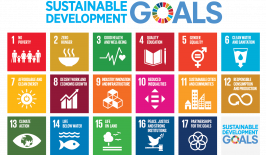“Building a resilient infrastructure, promoting inclusive and sustainable industrialisation and supporting innovation”: This is Objective 9 of the UN’s Sustainable Development Goals (SDGs). In the digital age, such a resilient infrastructure also requires access to information and communication technologies. By 2030, universal and affordable internet access in the least developed countries should be made possible.
According to the International Telecommunications Union (ITU), a specialized UN agency, only 53 percent of households worldwide have internet access. In the least developed countries of the world, the figure is as low as 15 percent. In these countries, many people use the internet from work, schools and universities or from other public connections outside the home. Mobile internet on the mobile phone in particular is booming in such countries, mostly due to lower prices and better availability. Nevertheless, the number of people in these countries who have access to these technologies is far below the global average.
Balloon-Borne Internet
Conversely, this also means that about half of the world’s population has no access to the internet. Grid connections are particularly rare in rural areas, where installing internet infrastructure of often very expensive and not worthwhile for telecommunications companies. With its SuperTowers, the US company Altaeros wants to send helium-filled platforms reminiscent of zeppelins into the skies to replace traditional terrestrial infrastructure. With a range of over 10,000 km2 per SuperTower, the balloons, which remain tethered to the ground, have a range equal to that of 30 conventional mobile phone masts. They also feature flight controls which reduce the need for personnel to monitor and operate the platforms, as well as diminish the costs associated with keeping them flying. Such balloons, could make traditional mobile phone masts obsolete, as well as speed up the provision of internet and mobile communications.
Altaeros was originally founded in 2010 at the Massachusetts Institute of Technology (MIT). Test runs with various mobile phone providers are scheduled for the end of this year. In 2019, the company plans to make the first SuperTowers available. Altaeros is also working on an airborne wind turbine at a height of 600 meters, which will be able to generate energy in strong winds, even at a high altitude.
However, as with Google’s Project Loon, the question arises here as to what extent the service is offered at reasonable costs. Balloons could have a monopoly position, especially in rural regions that are difficult to reach. It remains to be seen whether “affordable access to the internet” will then be offered, as the UN demands in its sustainability goal.
This article is a translation by Mark Newton of the original article by Jasmina Schmidt which first appeared on RESET’s German language site.






